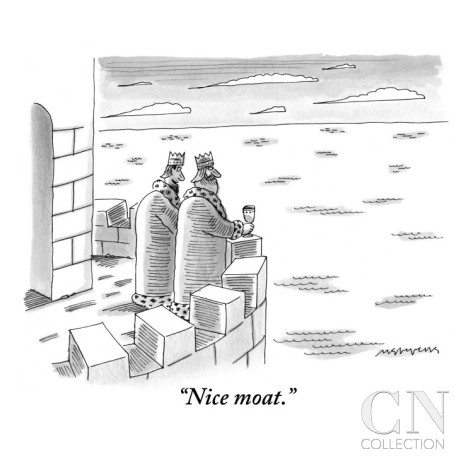So there we were…having an interview call for the second round of a startup award that we had gotten shortlisted for. Things were going pretty well until one of the jury asked the dreaded question, “What is your key differentiator?” Yes. You read that right. Game Over. K.O.
We (my co-founder and I) looked at each other, grappling with the answer, knowing full well that whatever we answered wouldn’t be enough. We firmly believe that our customer service and the way we deliver it truly sets us apart from the competition. But that fell on deaf ears. Can customer service actually be a real differentiator for a service startup?
We then lurched to the time old tested reply of, “We are the cheapest in the industry” (we really are), but the jury felt underpricing is more of a drawbridge than a moat. Essentially something that attracts the user to you but not something that makes him/her stay. Moreover it is something that is the easiest for a competitor to copy.
Which led us to the third option, technology. Yes! We had it. Our technology was our differentiator, we said. Surely that must do the trick, throwing around jargons like “Mobile First” and “Exponentially increasing usage/penetration”. Against the backdrop of the industry which we operate in – Finance – highly regulated and antiquated in terms of technology, with standard white label solutions being the norm, including us for now.
Which leads me to ask the question, “What really counts as a differentiator for a startup?” Do investors and investor sorts ever stop for a second and consider the effort it takes to just setup a working operation. From scratch. That founders might just be too busy in any of the operational tasks from making sure that the broadband doesn’t disconnect to employee retention to ensuring customer support levels. And isn’t traction, a recurring revenue stream and month on month growth enough, at least for the initial years?
And does the consumer really see a differentiator, even if one might exist? I, like million others, order books online. And the only differentiator I see between Flipkart and Amazon is the price (including delivery) and I naturally order from wherever is the cheapest. Where is the moat there?
Or take the case of India’s three biggest private banks – ICICI, HDFC and Axis. What is the differentiator between the three in terms of a savings bank account for a retail client? All three are present pan India, with more or less the same FD rate, the same RM policy and the same brand trust.
Is “The market is too big to worry about competitors” the right answer in some cases?
-Siddhant, Co-Founder & COO, SAS Online
(@sidd2015)
Awarded the
“RodinStar” Post
of the week!!







asha chaudhry
siddhant,
THIS IS AWESOME! i just love this post!!! and it’s your debut post!!
you have raised a valid point!!
we all say “ideas aren’t unique, the execution is…” and always ask “what sets you apart” etc etc
i love your analogy with flipkart and amazon. it’s both PRICE & CUSTOMER SERVICE that is makes you decide (yeah, yeah price is more of the deciding factor, but if an ecom site pampers me, i would tend to lean that side if the price difference isn’t too much!)
coming back to – “Can customer service actually be a real differentiator for a service startup?”
in a service startup like sushrut’s hammer & mop – YES.
in a tech service startup – i wouldn’t know.
let me ping some rodinhooders…
Siddhant Jain
Hi Asha…thanks a lot.
Subrata Bera
Hello Siddhant, nice post there.
People love to bank with HDFC as they are comfortable with the brand, can expect a fast service, a branch within easy reach, trust, connected services, mobile apps. In short a complete ecosystem to give them a pleasurable banking experience. Most of the other banks lack many of these features. Is that a moat?
Which brand of honey do we prefer? Dabur? Which brand of adhesive do we prefer? Fevicol?. Why? Because of their availability, awareness (advertisement) and also because we trust them? Is that a moat?
Same goes with many other brands. Look around and we will find ourselves among many of these products and services which we trust and can’t live without. Even when the alternatives are available we usually prefer these brands.
It takes a lot of time and effort to build this trust among the customer. And in my humble opinion that can be considered as Moat. Something which cannot be bought by money.
Regards,
Subrata Bera.
@subratabera
Siddhant Jain
Hi Subrata, definitely agree with you on those examples and your general take as well.
But these brands are what they are after years and years of existence. In the starting of it all, there is no moat. Similarly for startups.
Puneet Nirogam Aggarwal
Siddhant – I agree with you.
@Subrata : Is Brand built after so many years, a great example of a Moat. Say Nestle (100 years old), Maggi (30 years old) deep enough to be a moat. They were jolted by a problem. The trust was destroyed. Late entrants like ITC’s Yippee, was able to almost swim across in their difficult times.
Moats have to be unbreakably deep.
Puneet Nirogam Aggarwal
“In business, I look for economic castles protected by unbreachable moats.” – Warren Buffet
While this may be relevant to designing an investment strategy, but in reality, more than the product and service, its the culture of the company, founder and thought leaders of the company that describes a moat. Zappos, for example is an e-commerce player. What differentiates them is their awesome inspiring culture
Other things that you can use to build your moat is Superstar Team Players, processes, exceptional/unbiased/heart-warming customer sevices, values, strategy. These are the things which are not easily breached. If this is built in the moat, then for anybody to breach it, it would require a complete organisational dissection and reprogramming to bring about this change.
Infact your Moat is a MOAT good enough, if what you preach is not even taken seriously. Recently, I was talking to a group of marketing/MBA students. I told them that my mantra is “We don’t hard-sell, we don’t soft-sell, we just engage (nurture) and establish trust and that is when the selling happens automatically”. The group looked at me in disbelief and didn’t take me seriously. But I know that has remained our moat and it works for us.
priyanka desai
Hi Puneet, the two points you mentioned – 1. Inspiring culture and 2. Nurturing and building trust for the brand are so true for companies of all sizes, yet the toughest! But brands have been built on these two points supplemented by rockstar team, remarkable customer service, values and smart strategies. Completely agree with you.
And Siddhant, loved your post!
Siddhant Jain
Thanks Priyanka!
Siddhant Jain
Totally agree with you regards to culture Puneet.
Also, while I was writing, I couldn’t remember the Warren Buffet quote. That’s where the moat terminology inspiration came from. So thanks for that.
Sushrut Munje
Hey Siddhant – I’m afraid having a differentiator is crucial in a startup, else you are lost in the crowd. Customer doesn’t look for one, but without having one you might not have throngs of customers. When businesses grow in a competitive market, it is what sets them apart that decides the game. USP should be your company’s soul, what you kick off with, something that doesn’t and cannot change over a period of time. It might be the spirit of innovation (which shows through your reinvention of products) or expertise in a niche.
In my case (I build Hammer and Mop), our branded & customised cleanups were a fresh breath in the industry when there were older players. Even after the entry of aggregators (Housejoy, TaskBob, Zimmber, etc) now, our target segment is intact because we have focused on being a niche player & a specialist. While the general argument would be that we cannot scale – we have decided not to, it’s a business decision. But our differentiator (specialization and yes, the intangible customer service) has helped keep our business intact (and growing).
Customer service cannot be the sole differentiator – but it helps. You need to have intangible and tangible differentiators. Intangible because it helps keep others guessing, no one realizes you you cracking it. Tangible – converting your intangible magic into tangible units – thus helping raise money and have channel partners.
A very senior VC (who I have approached for advise at crucial junctures and who has also been a dear patron since long) once asked me to “stop trying to make an elephant dance”, which led us to break down “a cleanup” into smaller focused packages “kitchen cleanup”, “washrooms cleanup”. It was unheard of at that time and really helped.
Best wishes – and work on building a USP 🙂
Siddhant Jain
Hey Sushrut, thanks for sharing. Quite insightful.
Mubaid Syed
Hi Siddhant,
Amazing post. Can relate to all the points you mentioned.
From customer’s perspective, good products and Awesome Service is enough to make you stand out of the crowd even if the product is not unique..
Siddhant Jain
Thanks Mubaid…finally a kindred spirit!
Mubaid Syed
🙂 Sadly, its not an acceptable answer for startup eco-system. But its one of most imp factor I would say for your business growth.
asha chaudhry
hey siddhant,
i just had to mess up the bottom of your post! sowrie 🙂
Subrata Bera
I agree with that Puneet and also with Siddhant. It is a bit difficult for new entrants to build the moat right away but I believe we have such examples.
Moats can be expanding or contracting and any breach of trust can be disastrous. Quoting Warren Buffet, “It takes 20 years to build a reputation and five minutes to ruin it.”
Siddhant Jain
Haha…I don’t mind at all. Thanks a lot!
Saurabh Sharma
Very Relate-able. and raises an important question. especially for bootstrapped startup units, is assembling the palace of cards (ala – playing cards) the primary concern, or finding & maintaining a differentiator.
I guess execution alone can be the workable differentiator once the engine starts, as everything else is not guaranteed to be a differentiator all along the way, and could anyday be cloned. A product/offering serving a real need with good user experience I think is what we shall focus on.
Enjoyed the read. All the best to all 🙂
~Saurabh (@saurshaz)
Alok Rodinhood Kejriwal
While the overriding topic is hard hitting, I think you have taken it too literally.
Flipkart’s “original” moat was COD
Then it became Best in India
Now its probably going to become App only?
The point is – Investors want to know what kind of treadmill you are running on and how can you last. The moat is just a temporary obstacle before the race
Soma Srikanth
Hi ,
Every product and service needs to have its USP aka moat , i agree with you that it cant be built in a day however from VC perspective he is looking how are you going to sell you product amidst all the clutter and standout to make all the stakeholders rich. i presume the VC’s are looking at your secret sauce which can sell your product. We as Entrepreneurs cant put a finger on it who else can……
Price can be your first moat and growing with those first customer’s who we sell can be the bridge for us to go to next step….
Just my thoughts Siddant…..i am sailing in the same boat.:)
Siddhant Jain
Sure, makes sense Soma. It’s just as you said, difficult to find at first.